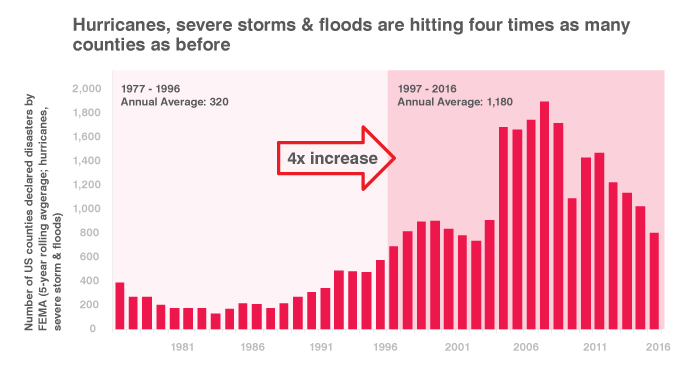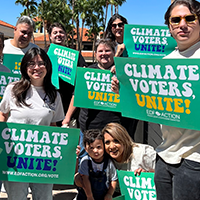New data shows changing disaster trends – and why Congress should take note
 The outpouring of support after hurricanes Harvey and Irma showed us, once again, that America is at its best when we rally behind our common values and help others in need.
The outpouring of support after hurricanes Harvey and Irma showed us, once again, that America is at its best when we rally behind our common values and help others in need.
Remarkably, those terrible disasters seem to have even knocked an uncommon dose of common sense into Congress. Lawmakers had been on the verge of passing sharp cuts to the federal disaster relief agency to fund President Trump’s border wall, but reversed course faster than you can say “whiplash.” They quickly passed a $15 billion aid bill for Harvey instead.
What Congress isn’t doing is to take the next step and look at how disaster trends have changed, and ask why they’re costing taxpayers ever-more money – so we did it instead.
The results of our analysis should add to Harvey’s and Irma’s collective wake-up call for policymakers who rush to respond to every disaster, but plan for none.
A fourfold jump in disasters since the 1970s
After examining the Federal Emergency Management Agency’s disaster declaration records from the past 40 years, we found that four times as many counties were hit by disaster-scale hurricanes, storms and floods between 1997 and 2016, than during the two decades before that.

It’s costing taxpayers billions
Harvey and Irma have exceptional price tags due to their destructive rains, winds and reach – Harvey will likely be the nation’s costliest disaster with an estimated $200-billionprice tag – but disaster relief for federal, state and local agencies has been on the rise for some time.
Between 2004 and 2013, FEMA spent more than $95 billion from the Disaster Relief Fund to help states and local communities cope after disaster struck. There were 32 percent more presidentially declared major disasters during this period than during the preceding 10 fiscal years, according to the General Accounting Office.
The number of disasters exceeding 1 billion dollars in damages, meanwhile, has doubled in the past five years, NOAA reports.
At the same time, the geographic reach of such events has exploded. During the past 20 years, 1,180 countries on average were affected annually – up from 320 countries during the two decades before that.
Will Congress take the lead?
The question now is whether Congress is ready to take responsibility and help our communities prepare for future storms. Such planning must come on four fronts:
- Scientific honesty: Climate change turns storms into disasters. Warmer ocean temperatures and air temperatures can lead to heavier downpours and stronger winds. So Congress must not stand by idly when politics subverts climate science. Without an honest assessment of what is going on, planning will misfire, leaving people and property needlessly at risk and wasting resources.
- Resiliency: We know how to improve resiliency to future storms and floods. The first line of defense is often wetlands and other natural systems that have the power to sponge up the worst flooding impacts. We also know to build infrastructure well above the “100-year” historic flood zone. Unfortunately, federal agencies are now hamstrung from acting on that knowledge after President Trump issued an executive order that pulls the plug on science-based flood planning.
- Preparedness: Congress should provide an adequate and reliable form of disaster funding that removes it from the whims of other political and budget fights. Modeled after the Superfund and Oil Spill trust funds, a fee on coal, oil and natural gas based on carbon emissions could secure adequate funding for FEMA’s Disaster Relief Fund.
- Prevention: Politically motivated denial of climate change has kept government from addressing the climate problem at its core by reducing the pollution that turns storms into super storms. To prevent such catastrophies, this goverment paralysis must stop.
In the end, disaster relief and planning aren’t sufficient by themselves. Today, Congress sits idly by as the Trump administration sweeps aside programs to reduce greenhouse gas pollution.
Until we resolve to act on climate change, we will continue to set the stage for the next Sandy, Harvey, Irma, Matthew or river flood. It’s not a question of whether we know enough to act, but whether we care enough to put problem-solving ahead of politics-as-usual.
This blog was originally posted on EDF’s Voices Blog.



